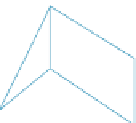Graphics Reference
In-Depth Information
y
z
x
Figure 13.7: The standard perspective view volume is the pyramid that ranges from
−
1
to
1
in x and y, and from
0
to
−
1
in z. The scale in z is exaggerated.
and similar expressions determine
θ
v
, the vertical field of view, and the length
of
AC
:
P
=
Position
(13.9)
A
=
P
−
f
w
(13.10)
B
=
A
+
f
tan
θ
h
2
u
=
P
+
f
tan
θ
h
2
u
−
f
w
(13.11)
C
=
A
+
f
v
=
P
+
f
tan
θ
v
2
v
−
f
w
.
(13.12)
Notice that the near-plane distance
n
has not entered into our computations
yet.
We now use the four points
P
,
A
,
B
, and
C
to transform the view frustum to
the standard view frustum shown in Figure 13.7, and known as the
standard per-
spective view volume.
All we need to do is say where the four points should be sent. We want to send
P
to the origin,
A
to the midpoint of the back face, which is
(
0, 0,
−
1
)
,
B
to the
mid-right edge of the back face, which is
(
1, 0,
−
1
)
, and
C
to the mid-top edge,
which is
(
0, 1,
1
)
. The matrix that performs this transformation is denoted
M
per
(for “perspective”), so we'll call the associated transformation
Tper
. The code that
creates our transformation is
−
1
2
3
4
Transform3 Tper =
Transform3.PointsToPoints(
P
,
A
,
B
,
C
,
Point3(0, 0, 0), Point3(0, 0, -1)), Point3(1, 0, -1), Point3(0, 1, -1));
Under this transformation, points of the far plane are transformed to the
z
=
−
1 plane. Since distances along the ray from
P
to
A
must transform linearly,
points of the near plane are transformed to the plane
z
=
−
n
/
f
. We're nearly done
at this point: We've transformed the view volume to a standard view volume, and
from this point onward,
almost
everything we'll do is independent of the camera
parameters, the exception being that the ratio
−
n
/
f
will enter into some of our
computations.























